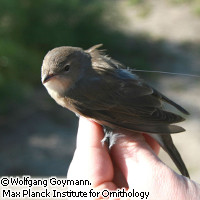For migrating birds ... it pays to be fat!
Birds with high levels of body fat take shorter refuelling stops on migration, allowing them to reach their breeding grounds faster and claim the best nesting sites, new research shows. The findings, published in the journal Biology Letters, highlight the importance of maintaining migratory birds' nesting sites, as the birds can only complete their migration if they have access to sites along the way that are rich in foods such as insects, nectar and pollen. Small migratory birds sometimes need to take a break to replenish their fat reserves, especially after crossing vast oceans or deserts. Factors known to influence the length of these stopovers are the weather, food availability and internal factors such as a genetically programmed urge to continue the journey. Scientists have suspected for some time that one of the main factors determining the length of the stopover is the level of the bird's fat reserves. The idea had never been properly tested - until now. In this study, researchers from Germany and Italy compared the stopover times of fat and thin garden warblers (Latin name Sylvia borin) arriving on the tiny island of Ventotene, which lies just off the west coast of Italy and is visited by many songbirds during migration. The team caught a number of birds over 2 mornings in May 2009 and scored their subcutaneous fat levels on a scale from 0 to 8. They picked 10 lean birds (with a fat score of 0 or 1) and 10 fatter birds (with fat scores of 3 or 4) and fitted them with temporary radio transmitters. They then monitored, on a regular basis, whether the signals from the transmitters could still be heard from the island or not. The results were clear. 'Fat garden warblers can make shorter stops to replenish their fat reserves on the taxing annual journey to their breeding grounds,' said Wolfgang Goymann of the Max Planck Institute for Ornithology in Germany. The fatter birds spent an average of just under nine hours on the island, with all but one leaving the island the night after they were tagged. In contrast, their skinnier counterparts spent an average of 41 hours on Ventotene before continuing their migration. 'We assume that the majority of birds arrived on the island the morning we caught them,' commented Dr Goymann. 'However, even if this were not the case, our data clearly revealed that fat garden warblers only waited until nightfall on the same day to move on. As opposed to this, the thin birds had to wait until they had accumulated sufficient fat reserves for the next leg of their journey.' 'We conclude that fat stores predict stopover duration in migratory garden warblers,' the researchers write. They added that the weather conditions were perfect for migration throughout the study period, so the differences between the two groups are likely to be due to internal factors like differing fat reserves. The other researchers in the study came from the Institute for Environmental Protection and Research (ISPRA) and the University of Ferrara in Italy.
Countries
Germany, Italy



